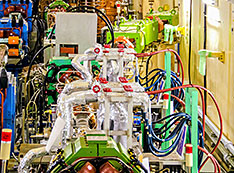
Brookhaven and the Belle II Experiment
Tracking particle smashups and detector conditions from half a world away, scientists seek answers to big physics mysteries
The Belle II experiment at Japan’s SuperKEKB particle accelerator, which started its first physics run in March 2019, takes “snapshots” of the decay products streaming from collisions of electrons and positrons to seek answers to some of the biggest questions in physics. A key part of the experiment is taking place half a world away, using computing resources and expertise at the U.S. Department of Energy’s Brookhaven National Laboratory, the lead laboratory for U.S. collaborators on Belle II.
The Goal of Belle II
The purpose of the upgraded Belle II experiment is to search for new physics phenomena that cannot be explained by the particles and forces already included in the Standard Model—the world’s reigning (and well-tested) theory of particle physics—while also making precision measurements of known phenomena.
One particular area of interest is the decay of “heavy flavor“ mesons. These are particles made of two quarks, one of which is a heavy “beauty“ or “charm“ quark. The study of the decay process (transformation into other lighter particles) of heavy flavor mesons has established that matter and antimatter behave differently. The observed differences are, however, not sufficiently large to explain why today’s universe is made of matter rather than a mix of matter and antimatter. Additional sources of matter-antimatter asymmetry must exist and, if observed, could indicate that some new, previously undiscovered particles might be taking part in the action. To identify such unobserved phenomena, scientists must analyze many times more heavy flavor meson decays than have ever been produced at past electron-positron facilities. Belle II will accumulate more than 50 times the data sample of the original Belle experiment at KEK, which itself produced 760 million such events.
Related News

SuperKEKB Collider Achieves the World's Highest Luminosity
Friday, June 26, 2020
Japan's flagship electron-positron collider, SuperKEKB, achieved the world's highest instantaneous luminosity for a colliding-beam accelerator

Belle II explores new "portal" into dark matter - First results from the Belle II Experiment
Wednesday, April 8, 2020
Belle II has published its first paper—a search for an elementary particle that acts as a “portal” between ordinary matter and dark matter.
Brookhaven Contributions
Software and Computing
The Belle II experiment produces multiple peta-bytes of data each year. That data needs to be carefully calibrated and managed, as it is shared with over a thousand physicists working all around the world. As the lead laboratory for the U.S., Brookhaven provides the necessary software and computing expertise with a team composed of members of the Nuclear and Particle Physics Software (NPPS) and Scientific Data and Computing Center (SDCC) groups. NPPS provides the software and SDCC provides the computing to manage all of that data, collaborating on the Rucio Scientific Data Management software project. The team also provides the conditions database that manages the real and simulated detector conditions and calibrations. The complex calibration work that produces those conditions is performed at Brookhaven. The SDCC is the largest data center outside Japan serving the Belle II experiment, it also provides the computing resources necessary to reconstruct, analyze and curate a large fraction of the real and simulated data. The team at Brookhaven collaborates with international partners on Belle II and other experiments and has leading roles in the HEP Software Foundation (HSF).SuperKEKB Accelerator
To keep collision rates high, the electron and positron beams that circulate inside SuperKEKB must be tightly focused. But the magnetic fields guiding the particles in one beam can have unwanted effects in the adjacent beam, causing the particles to spread. To fine-tune the fields of the accelerator magnets and counteract these adjacent-beam effects, Brookhaven’s magnet division constructed 43 custom-designed corrector magnets. These corrector magnets are installed on each side of the Belle II detector, making adjustments to both the incoming and outgoing beams to maintain high beam intensity, or “luminosity.” High luminosity results in higher collision rates, so physicists at Brookhaven and around the world will have more data to analyze.
Data Analysis
Physicists at Brookhaven Lab play a leading role in searches for new sources of matter-antimatter asymmetry by studying decays of charm mesons. While the existence of matter-antimatter differences in beauty mesons has been known for decades, these differences have been observed only recently in charm decays by the LHCb experiment at CERN, the European laboratory for particle physics research. Studies at Belle II will complement those ongoing at LHCb and will allow scientists to understand whether the observed matter-antimatter asymmetry can be explained by the Standard Model or is caused by new phenomena.
The Belle II Detector
The 8-meter tall, 1,400-ton Belle II detector surrounds the collision point of the SuperKEKB accelerator. Its purpose is to measure the trajectories of particles produced by meson decays, identify them, and reconstruct their energies and momenta. It's similar to a digital camera that measures all relevant information about particle decays and data on the conditions of the camera at the time of each collision, which must be properly taken into account to make sense of Belle II's measurements.





